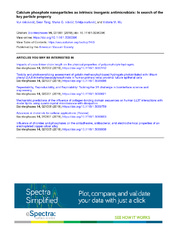Приказ основних података о документу
Calcium phosphate nanoparticles as intrinsic inorganic antimicrobials: In search of the key particle property
| dc.creator | Uskoković, Vuk | |
| dc.creator | Tang, Sean | |
| dc.creator | Nikolić, Marko G. | |
| dc.creator | Marković, Smilja | |
| dc.creator | Wu, Victoria M. | |
| dc.date.accessioned | 2019-10-11T12:16:57Z | |
| dc.date.available | 2020-05-20 | |
| dc.date.issued | 2019 | |
| dc.identifier.issn | 1934-8630 | |
| dc.identifier.uri | https://avs.scitation.org/doi/abs/10.1116/1.5090396 | |
| dc.identifier.uri | https://dais.sanu.ac.rs/123456789/6468 | |
| dc.description.abstract | One of the main goals of materials science in the 21st century is the development of materials with rationally designed properties as substitutes for traditional pharmacotherapies. At the same time, there is a lack of understanding of the exact material properties that induce therapeutic effects in biological systems, which limits their rational optimization for the related medical applications. This study sets the foundation for a general approach for elucidating nanoparticle properties as determinants of antibacterial activity, with a particular focus on calcium phosphate nanoparticles. To that end, nine physicochemical effects were studied and a number of them were refuted, thus putting an end to frequently erred hypotheses in the literature. Rather than having one key particle property responsible for eliciting the antibacterial effect, a complex synergy of factors is shown to be at work, including (a) nanoscopic size; (b) elevated intracellular free calcium levels due to nanoparticle solubility; (c) diffusivity and favorable electrostatic properties of the nanoparticle surface, primarily low net charge and high charge density; and (d) the dynamics of perpetual exchange of ultrafine clusters across the particle/solution interface. On the positive side, this multifaceted mechanism is less prone to induce bacterial resistance to the therapy and can be a gateway to the sphere of personalized medicine. On a more problematic side, it implies a less intense effect compared to single-target molecular therapies and a difficulty of elucidating the exact mechanisms of action, while also making the rational design of theirs for this type of medical application a challenge. | en |
| dc.publisher | AIP Publishing LLC | |
| dc.relation | United States National Institutes of Health (NIH) / National Institute of Dental and Craniofacial Research (NIDCR), Grant K99-DE021416 | |
| dc.rights | embargoedAccess | |
| dc.source | Biointerphases | |
| dc.subject | nanoparticles | |
| dc.subject | antimicrobials | |
| dc.subject | calcium phosphate | |
| dc.title | Calcium phosphate nanoparticles as intrinsic inorganic antimicrobials: In search of the key particle property | en |
| dc.type | article | en |
| dc.rights.license | ARR | |
| dcterms.abstract | Николић, Марко Г.; Ускоковић, Вук; Wу, Вицториа М.; Танг, Сеан; Марковић, Смиља; | |
| dc.citation.spage | 031001 | |
| dc.citation.volume | 14 | |
| dc.citation.issue | 3 | |
| dc.identifier.wos | 000468801600001 | |
| dc.identifier.doi | 10.1116/1.5090396 | |
| dc.identifier.scopus | 2-s2.0-85065959658 | |
| dc.type.version | publishedVersion | |
| dc.identifier.fulltext | https://dais.sanu.ac.rs/bitstream/id/26101/Uskokovic_Biointerphases_2019.pdf | |
| dc.identifier.rcub | https://hdl.handle.net/21.15107/rcub_dais_6468 |

